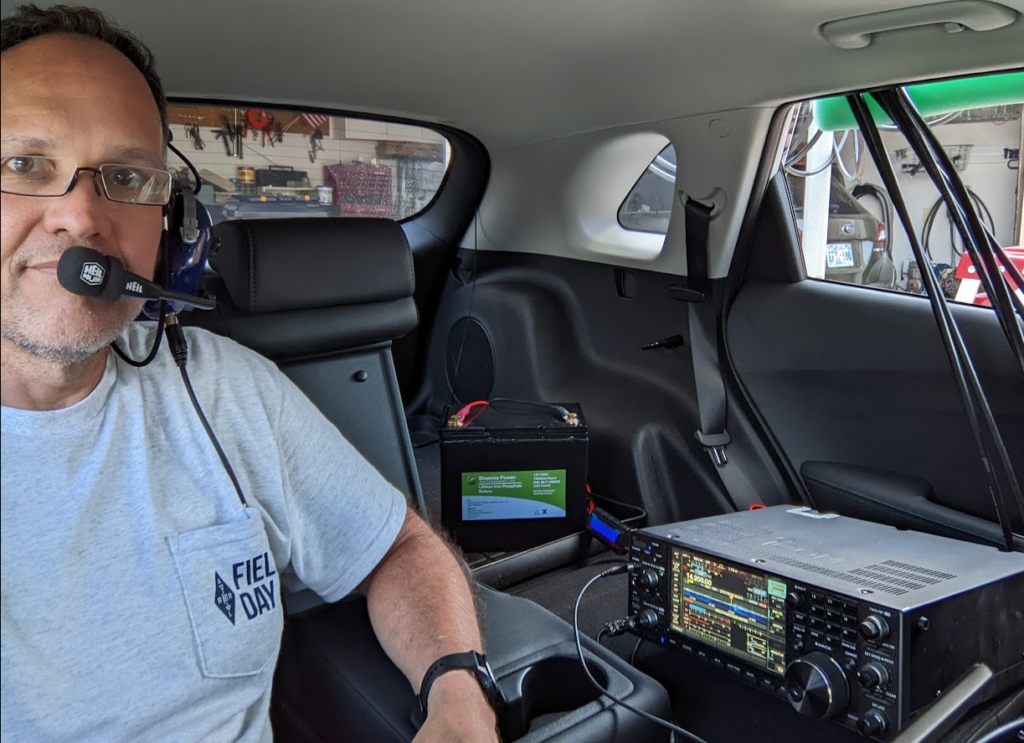20-Aug 2022: My first park activation, K-0493, GRID EM04 Wichita Mountains Wildlife Refuge & Mt Scott Project
This was my very first registered POTA. I love the Wichita Mountains Wildlife Refuge (WMWR) – it is a beautiful place to visit but the weekend can be crowded. The 100+ F summer heat finally gave way to rain and 90 F for a few days so my visit was during a crowded time but it was wonderful!
I made a previous trip on July 12 to Mount Scott while Lisa was attending a conference in Duncan. On a whim I tried accessing the K5EOK repeater on my ¼ wave whip antenna and it was full strength! I then, on a whim, switched to 146.52 MHz and made several contacts in Stillwater, and even into Kansas. I was completely unprepared and missed some callsigns and had to chase my paper log across the parking lot when the wind blew through the car. I couldn’t wait to return some day with a plan and a more sophisticated setup. A week later I attended Ham Holiday (July 23) where our Oklahoma Section Manager announced the first ever Oklahoma POTA – requesting all HAMS to get all Oklahoma Parks on the air August 20/21. This was the purpose I needed, my call to duty 🙂 This was my first POTA activation and unfortunately I only had 3 weekends to decide, design, order, build and test so I had to get busy fast! Also unfortunately the chosen activation date was during the NCJ phone contest.
My rapid deploy vertical mast (or jousting rod) and short ladder on the roof rack.

On the air with 2m and 6m Moxons from PAR Electronics, Inc..

My desired outcome
Activate a park while sitting in my air conditioned Kia Niro EV, without using trees or fence posts as tie-offs (fully self-sufficient and ‘on my own property only’ and be able to take on any road trip and be on-the-air within 10 min of parking. (Editing Marcus: When I wrote that goal it was 105 degrees. The heat wave ended and I could have operated without the A/C but I used it anyway since I wanted the window closed!)
My Bands (antennas)
Originally I wanted 17, 15, 12, 10, 6 and 2m full size monoband antennas with a manual antenna switch for 17-10m). My initial thought was ham sticks however shortened antennas do not receive well so I built a mast and a removable boom and removable monoband diples (monoband bazookas – not great but low noise). I also purchased a Par Electronics SM-50, 6M Stressed Moxon, and OM-144, 2M optimized Moxon.
(Editing Marcus here: all the HF antennas makes the mast too heavy to lift so I had to make it one I could leave on top of the car for 2 and 6M but park the car upon and erect for all the other bands, however this design extended into adjacent parking spaces and it’s big so I emailed the park to query if it was acceptable. They called me back and explained that I need a permit for anything of that size or anything that is not attached on the car or takes up more than my one parking space or obstructs people’s view. To request a permit I must file a request with a plan and at minimum it takes 45 days, sometimes 60 days to receive approval. By this point the event was just a few days away so no time to redesign or mail order anything.)
After my trip I decided to try using the roof rack setup but place a truck, halyard, hook and cleat on it to raise and lower a single full length vertical dipole quickly like raising a flag. I could do this using a short section of PVC pipe clipped to the string as a coax holster and dipole center handle to pull the dipole center away from the coax and keep at least a foot of separation parallel from the bottom element.
Power
For DC power I purchased a Bioenno Power 12v 60 Ah LiFePo4. I may add solar in the future however for my first attempt I do not need the added stress of packing/unpacking/hookup/securing-stabilizing solar panels in wind nor do I want the electronic buzz of DC-DC converters. Just a deep cycle light weight battery from Bioenno Power who attends ham conventions and helps the ham community. https://www.bioennopower.com/collections/lifepo4-batteries-for-communication-equipment-ham-radio/products/12v-50ah-lfp-battery-abs-sealed-ws
Both radios, receive-only consumed 5.2 Ah. So both radios in 50 Ah would be 9 hrs of receive only. Therefore, with transmit time 50 Ah is not going to be a lot of time. For a longer trip I will need a second battery.
– 2.3 Amps for IC7610
– 2.7 Amps for IC9100
Sadly the Windows USB driver is not working for the IC9100 – therefore I can only use it for 2m SSB and FM without the Raspberry Pi and I want to keep it simple! (Editing Marcus: I drastically over estimated how much transmitting I would be doing since the IC9100 was limited to phone only and the HF antennas never went up)
Logging
Many suggested using the “HAMRS app” but it does not log data therefore I would still need Log4OM for WSJT modes. Therefore I set up Log4OM portable with a POTA dB for logging WSJTX and phone. If I’m able to operate more than one day then I would create one log per day and per park (although I will only be in one park and only one day). (Editing Marcus: Log4OM worked great and it easily exported everything to ADIF. I uploaded my log shortly after arriving home). I also took along an ARRL paper log as a backup in case all else fails, and it’s heavy enough to not blow out the window!
Radios
IC9100 for 2m SSB, FM and to monitor for 6m activity. The Windows driver on the laptop will not connect to the IC9100 over the USB cable so WSJT is inoperable on the IC9100 without my Raspberry Pi which has no problem talking to the IC9100 and C7610 over USB. Ironically, the same Windows USB driver for the IC7610 works fine so I used it for 6m WSJT and HF. (Editing Marcus: IC9100 for 2m USB and FM, IC7610 for 6m – I did not setup HF due to the arrival of rain and lightning.)
What happened
I arrived several hours late (I didn’t pack the night before) and the hilltop was busy but a perfect parking spot on the edge was available. I began to set up and simultaneously answer questions from individuals walking by (if only visitors counted toward my goal!). I also met several hams from other states so it was fun! I wish I was prepared to answer questions about amateur radio but I never got to that part of my pre-trip checklist. After what seemed like an hour of setup I was finally on the air with 2m and 6m (I really need a quick disconnect clamp for these two antennas). I made some contacts, got out, rotated the mast, and called CQ again. I continued this process for 360 degrees a couple of times. The last time I got out of the car was when I saw the lightning and the wind blew leaves into my face (there are not any trees up there – just rocks!) I quickly realized it was time to disassemble and go before I was trying to do so in a heavy rain. After I left the peak I drove around to all the areas of the park I wanted to view for the following day or a future return trip. The rain was fairly light and the lightning had moved away, however my ladder and the roof of the car was too wet and the wind was too strong to consider climbing atop the car and hanging a dipole vertically as a test. I returned to the hotel but on the way I snuck up on a group of Elk that were crossing the roadway and going up a hill. I finally made it to the hotel, exhausted, at about 9pm. The next day I ended up just returning home as it was still raining and our Starlink was offline (it began having problems the past week-first time in many, many months). That’s it. I made just enough contacts to be a legitimate activation but I had a lot of fun and gained some ideas for a future trip.
What is next
I want to return to this park and operate HF.
I also need to bring and practice my ‘elevator speech’ regarding “What is Ham Radio”.
Then I need to look at other parks across Oklahoma and their elevations as well as forming a network of people to notify when I’m going to operate simplex. Furthermore I need to plan to be on the road during the VHF contests. For this I need to procure the IC-9700. Possibly for those I add another 2×8 and PVC stand with 2m, 70cm and 23 cm gain antennas on a rack. I would need to park at a high elevation and would need to be able to rotate the car around. I have to take advantage of finally having a car with a roof rack! I won’t compete in the contest but I can activate parks and maybe help get more Technicians on the air.
Construction
Design rules:
- Read your vehicle’s roof rack load limit!
- It’s not how fast you can drive, it’s how fast you can stop with everything still attached. Most cars use friction clamps for the roof rack and in an emergency stop you may overcome the friction holding them on! Go lightly, and keep as much weight as low as possible.
- Remember that if something comes loose it could kill someone. Be mindful of safety and inspect at every opportunity.
- Do not drink and drive because then using it as a jousting rod may seem like a great idea.
- Do not have two horizontal masts as they could resemble blasters and invite Imperial stormtroopers to attack.
The mast is an MFJ-1906H. (Note: DXE-TCFP-33HD is a new Carbon Fiber version of the same thing! This wasn’t available in July!)
The tilt base is the DXE-VA-BASE
I also added the wing nut knobs, DXE-AOK-TB1193
The roof rack base and ‘shark fin’ is simply a pressure treated 2×8 cut to fit, allowing the hatchback to open. I also ensured the tail end (tongue) was long enough to be used as an ‘under the wheel’ base as I feared on top of the car it would require too much leverage to lift the the mast from horizontal to vertical. This tire tongue also allows it to be a versatile field antenna mast.
In the future I may add a second 2×8 with a ‘PVC Bookshelf’ frame to zip tie a 2m, 70cm and 23cm gain antennas onto like N0LD does or possibly to attach an AZ/EL rotor! Be mindful of highway windspeeds while driving against the wind through a storm outflow. Also more wind drag means less vehicle efficiency.
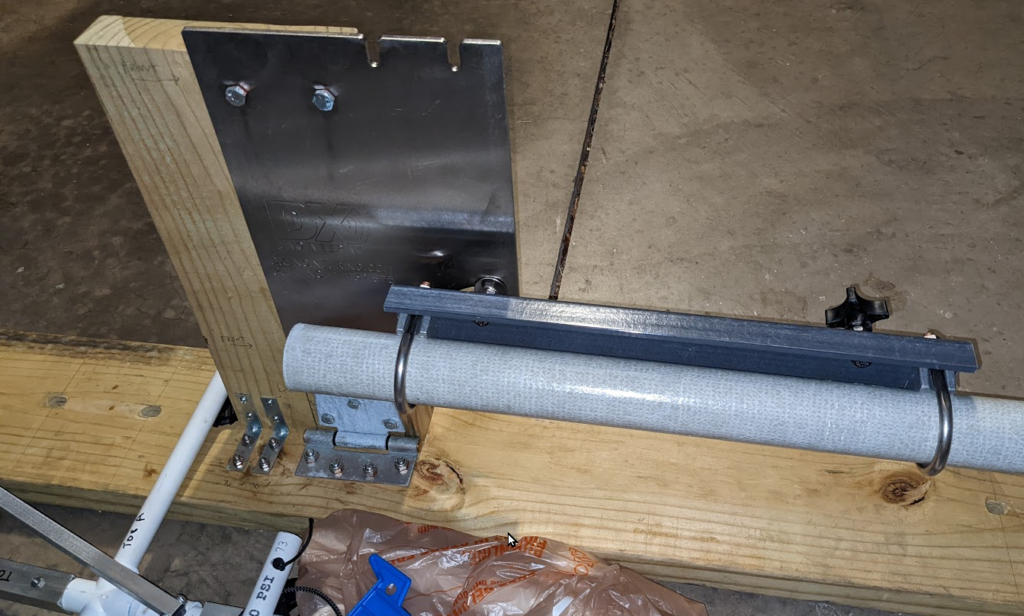
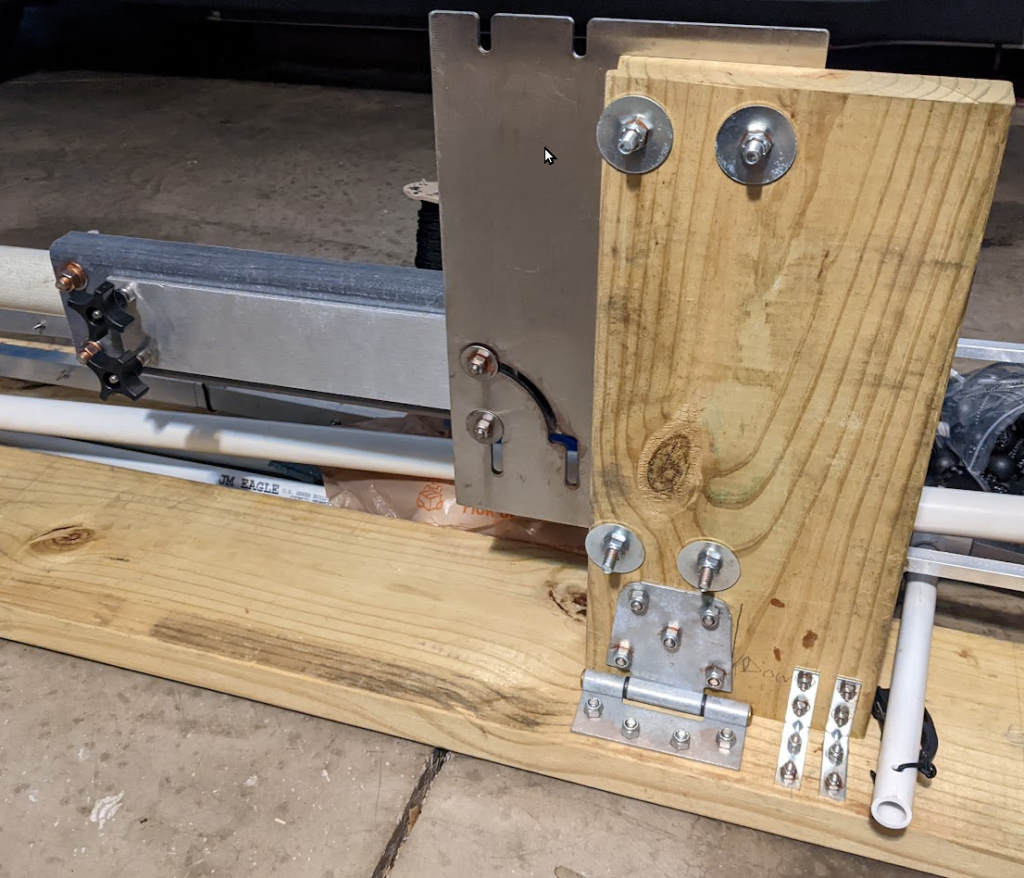
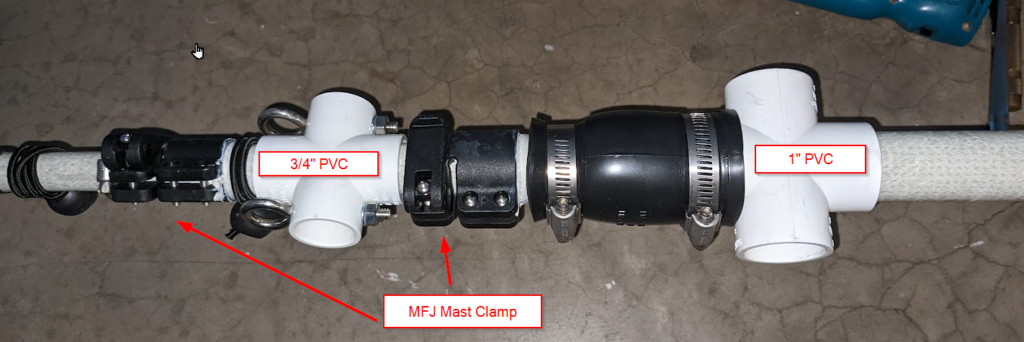
Materials
2×8 pressure treated lumber
Pair of ⅜ in x 4 7/8 inch U-bolts (my roof rack is wide)
(2) Tee Hinges, 3 ½ inch galvanized hinges (I could not find large corner braces with matching holes back-to-back)
(2) pairs of 2 inch corner braces zinc plated for added support and to dampen any rocking.
Nylon lock nets where possible to prevent highway vibrations from causing rapid disassembly.
#8-32 x 2 inch machine screws
5/16 in bolts
Misc: Camjam cord tightner 4pk
Eyebolt ¼ inch nut – ⅝ inch
To mount the DX Engineering plate to the ‘fin’ I used 3/8 in x 2 ½ in bolts and 5/16 in x 1 ½ in fender washers and nylon lock nuts.
On the MFJ fiberglass mast (I hate fiberglass!) I used Gorilla adhesive to glue on the tube clasps and to thinly coat the cut ends of the fiberglass tubes to reduce fraying and unexpected cuts. Before any assembly I also showered the fiberglass tubes and wiped them as well as possible with paper towels inside and out to wash away the glass dust. You do not want this dust on your hands, in your eyes and certainly not in your lungs. Be careful! Of course after this trip DX Engineering had a carbon fiber kit in stock.
I found a few sections where standard SCH 40 PVC pipe was a very good fit or good enough. For the latter I had to use rubber pipe joiners with hose clamps. The bottom PVC cross was basically used as a handle to help me push up the mast. The middle and top were working components.
¾ in PVC cross (for rope loops)
1 in PVC cross (for horizontal boom)
1 ¼ in PCC cross (for lower horizontal boom and/or handle)
1 ¼ in rubber coupling
1 ½ in rubber coupling
The mast cannot be extended fully without guy ropes, unless possibly while in a location without wind but wind in Oklahoma is so prominent it is the first line of the song ‘Oklahoma’. To extend the mast requires an A frame ladder to get one or both feet on the roof rack and the 2×8.
For supporting multiple full length HF antennas horizontally I also added several 96 in x 1 in x 1 in square tube aluminum, and mated sections together using ½ in PVC pipe with ½ in x 36 in oak dowel through the PVC for rigidity. This created a horizontal boom across the vertical mast. Before switching to aluminum I tried using PVC pipe alone and found it miserably floppy regardless of where I guyed it to the mast. PVC pipe with oak dowel rod filling continued to be unusably floppy therefore I had to substitute the majority of PVC with the aluminum tube. By hanging this tube as a horizontal boom at the middle of the vertical mast allows 20, 17 and 15m to be suspended from the top center in an inverted V style with their ends tied to the boom. I was then able to suspend 12 and 10m below the boom.
Here is a photo of the entire thing going up one section at a time. Here you can see how miserably floppy the PVC proved to be although in this photo, the first 96 inches was aluminum tube.
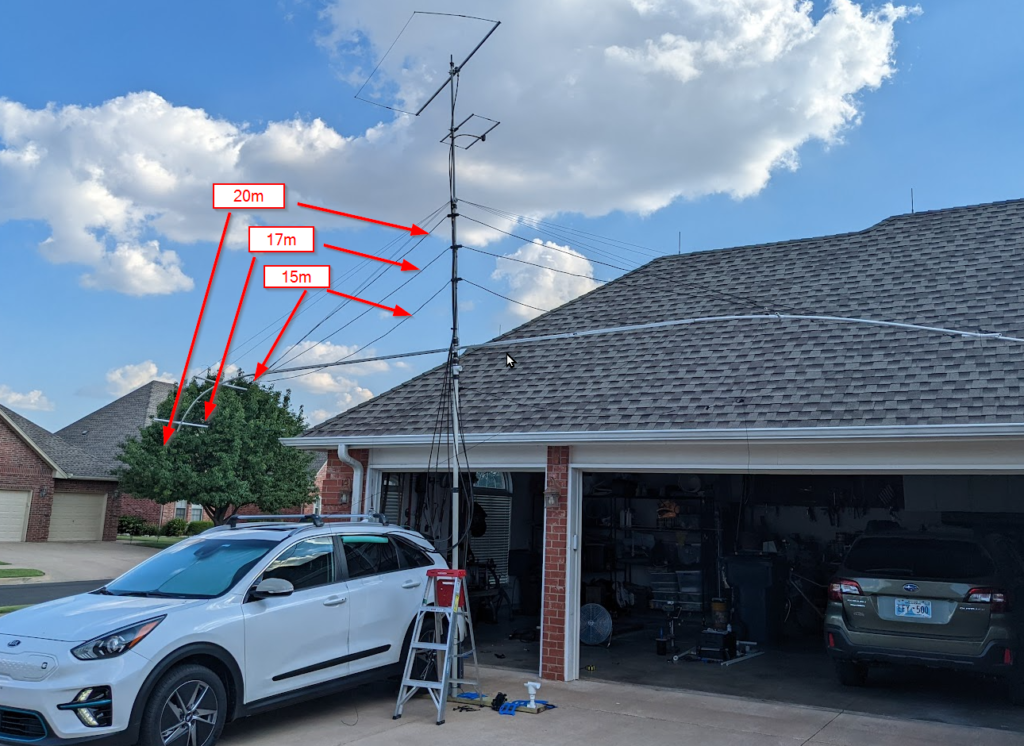
This still needed to be pushed up a further but I had not yet attached the 12 or 10m dipoles. These are obviously not ¼ wavelength from the ground but I was hopeful being at the edge of a mountain would help with my take-off angle. Also the platform has to be placed under the tire as it is otherwise too heavy to push up and I fear the torque created from a bit of wind could be disastrous for the roof rack. In this setup I use a MFJ 4-way manual coax switch. This would allow working up and down the bands from one parking location (although using more space than 1 parking spot). Another problem with this design is rotation. Rotating the entire mast to point the 2m or 6m antenna requires some core body strength.
A likely better option option is to operate ‘flagpole’ style and hang a single ½ wave dipole vertically and pull-up one at a time. This can be performed with the fiberglass mast on top of the car. I hope to test this soon, however it removes the ability to simply switch from one band to the next without getting off the radio and switching out antennas.
23-July 2022 OK POTA challenge
At the 2022 ‘Ham Holiday’ our ARRL Oklahoma Section Manager Mark Kleine announced a new first ever event, OKPOTA. See the announcement here: http://ok.arrl.org/okpota/ I’ve never operated POTA and I had just returned from a fun VHF experience on top of Mount Scott so I decided to jump in and activate a park. Therefore, Saturday Aug 20 I will be at Mount Scott and following this plan:
Sometime between 12:30 and 1:00 PM I will announce on the EARS repeater that I’m looking for QSO’s on 146.52 FM simplex. It’s a bit over 100 miles away so you will need a directional antenna. I will then follow this plan:
| Band | Freq (MHz) | Mode | My antenna | Radio |
| 2 m | 146.52 (up 15kHz steps if QRM – 146.535, 146.55, 146.565…) | FM | Horizontal moxon | IC9100 |
| 144.200 | SSB | Horizontal moxon | IC9100 | |
| 1.25 m | 223.5 | FM | Only a vertical whip ant on mobile radio | Anytone AT-5888UV-III |
| 70 cm | 446 | FM | Only a vertical whip ant. | IC9100 |
| 6 m | 50.125 | USB | Horizontal moxon | IC7610 |
| 50.313, 50.214 | FT8/FT4 | Horizontal moxon | IC7610 |
After I’ve completed all the POTA contacts I can for the bands above I will take down my antennas and relocate to another less busy location in the park for the NA QSO Party. I plan to operate on 20, 17, 15, 10 and possibly 6m phone. As the sun sets I will pack up and leave.
Return here after the weekend for a few photos! But here are a few from the previous hot weekends…
